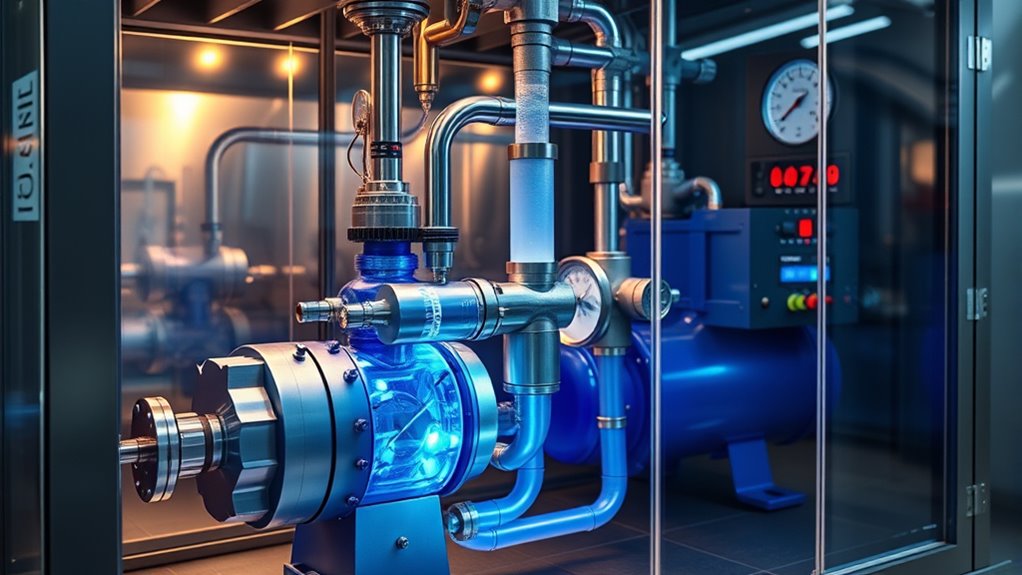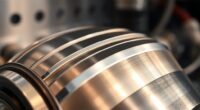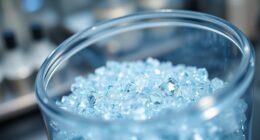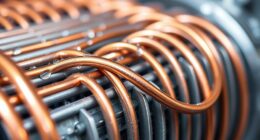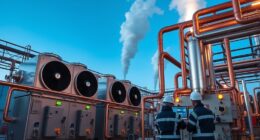Transcritical CO2 heat pump cycles operate across CO₂’s critical point, unlike traditional systems that stay below it. This allows for higher efficiency, especially in cold conditions, and reduces environmental impacts since CO₂ is non-toxic and has a near-zero global warming potential. To achieve this, system components are designed to handle high pressures and precise temperature control. If you want to explore how these systems maximize efficiency and sustainability, there’s more to discover ahead.
Key Takeaways
- Operates across the CO2 critical point, combining subcritical and supercritical processes for heat transfer.
- Utilizes a high-pressure compressor to raise CO2 to transcritical conditions, enabling efficient heat absorption.
- Employs specialized heat exchangers designed for rapid heat transfer in high-pressure transcritical cycles.
- Adjusts pressure and temperature precisely to optimize performance and efficiency during varying loads.
- Offers eco-friendly, energy-efficient heating and cooling solutions with low environmental impact.
How Transcritical CO2 Cycles Differ From Conventional Refrigeration Systems

Unlike traditional refrigeration systems that operate entirely below the critical point of refrigerants, transcritical CO2 cycles function across the critical threshold of CO2. This shift allows for higher system efficiency, especially in varying load conditions, because the compressor can adapt to different pressures more effectively. Additionally, transcritical CO2 systems have a lower environmental impact since CO2 is non-toxic, non-flammable, and has a global warming potential near zero. These features reduce greenhouse gas emissions and decrease reliance on synthetic refrigerants that harm the environment. Furthermore, understanding the refrigerant properties of CO2 is essential for optimizing system performance across different operating conditions. Overall, by operating across the critical point, transcritical CO2 cycles offer a more sustainable and efficient alternative to conventional systems, making them increasingly attractive for eco-conscious applications.
Thermodynamic Principles of Transcritical CO2 Heat Pumps
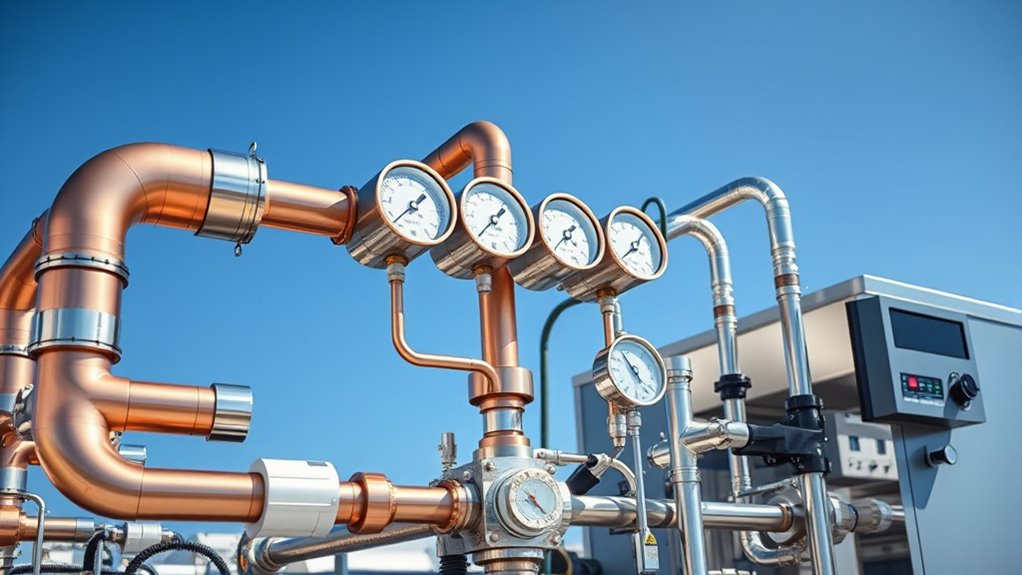
Understanding the thermodynamic principles of transcritical CO2 heat pumps is essential to grasp how they achieve efficient heating and cooling. Unlike traditional systems, CO2 operates across the critical point, requiring precise pressure management to optimize performance. During the cycle, the compressor elevates the pressure of CO2, and heat exchange occurs in the gas phase, where thermal efficiency depends on effectively controlling pressure and temperature. In the transcritical region, the CO2 doesn’t condense, so heat absorption happens at high pressures and temperatures, making pressure management crucial for maximizing efficiency. This process allows the system to adapt to varying load conditions, ensuring efficient energy use. Additionally, mastering AI Security aspects such as safety measures and monitoring can enhance the reliability of these systems in real-world applications. Mastering these principles helps you understand how transcritical CO2 heat pumps deliver sustainable, cost-effective heating and cooling solutions.
Component Design and Configuration of Transcritical CO2 Systems
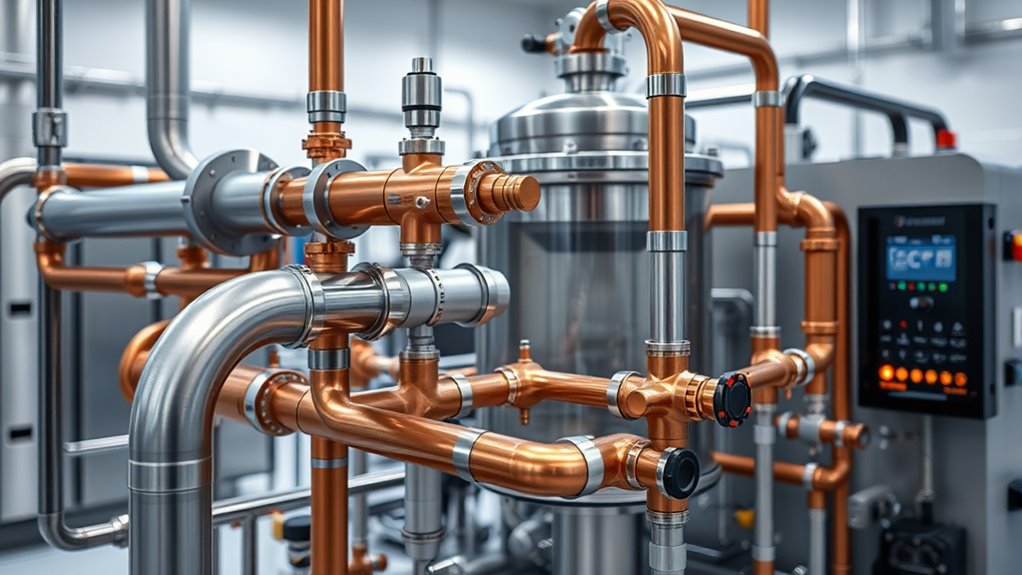
The component design and configuration of transcritical CO2 systems are tailored to handle the high pressures and unique thermodynamic behavior of CO2 in the transcritical cycle. You need to focus on component optimization to guarantee efficiency and reliability, especially for key parts like the compressor, heat exchangers, and expansion valve. Proper system integration is essential to manage the high-pressure environment and maximize performance. The compressor must be designed for durability under transcritical conditions, while heat exchangers are optimized for rapid heat transfer. The configuration should minimize pressure drops and ensure seamless flow control. By carefully selecting and integrating components, you guarantee the system operates smoothly, taking full advantage of CO2’s thermodynamic properties while maintaining safety and efficiency in high-pressure operation. Additionally, understanding the system layout can help in optimizing flow paths and reducing energy consumption.
Advantages of Using CO2 in Transcritical Cycles
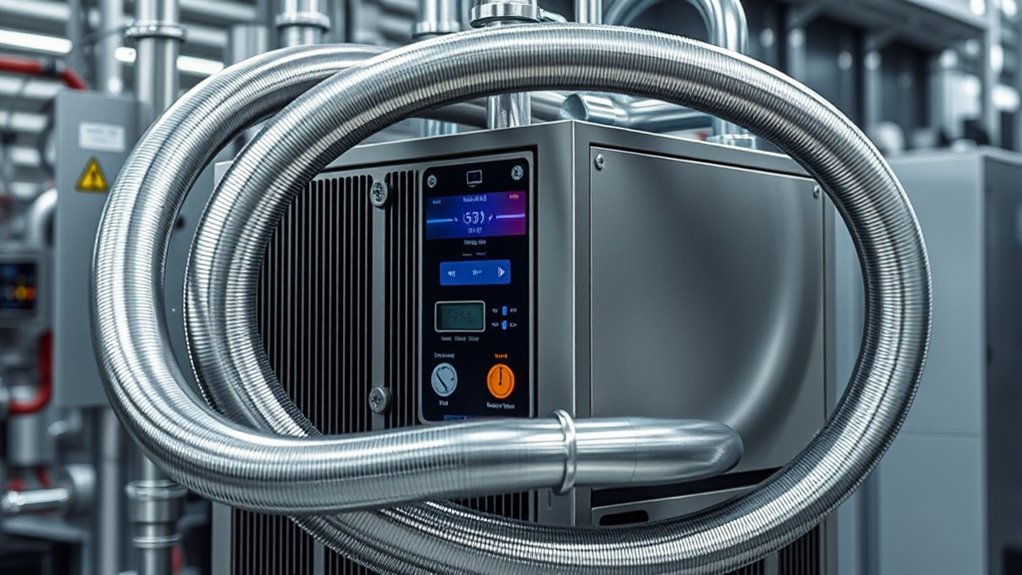
Using CO2 in transcritical cycles offers several compelling advantages that make it an attractive option for modern heat pump systems. As an eco friendly refrigerant, CO2 has a low environmental impact, with zero ozone depletion potential and minimal global warming potential. Its natural properties reduce reliance on synthetic chemicals, making it a sustainable choice. Additionally, CO2 enables high efficiency, especially in colder climates, because it operates effectively across a wide temperature range. This high efficiency translates to energy savings and lower operating costs. CO2’s stability and non-flammability also enhance safety, while its abundance and low cost improve overall system economics. Moreover, advancements in encryption solutions and cybersecurity measures help protect the data and control systems of modern heat pumps, ensuring safe and secure operation. These benefits make CO2 a forward-looking solution for environmentally responsible, high-performance heating and cooling applications.
Emerging Trends and Applications of Transcritical CO2 Heat Pumps
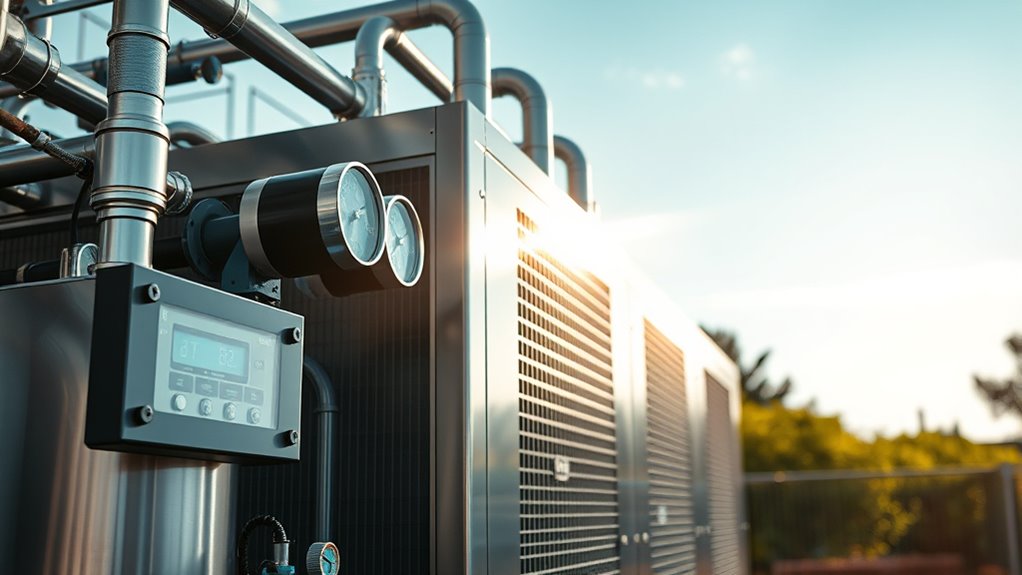
Have you noticed how transcritical CO2 heat pumps are gaining traction across various industries? The future market looks promising, driven by their efficiency and eco-friendliness. Innovations in compressor technology and system design are expanding applications from commercial heating to industrial processes. Policy incentives in many regions support their adoption, making them more accessible for businesses aiming to reduce carbon footprints. Emerging trends include integration with renewable energy sources and smart control systems for optimized performance. As governments push for sustainable solutions, transcritical CO2 heat pumps will likely see increased deployment in district heating, refrigeration, and hot water systems. Additionally, advancements in system efficiency are enabling these heat pumps to operate more effectively under diverse environmental conditions, further boosting their adoption. Staying ahead means embracing these developments, which promise cost savings and environmental benefits while shaping the future of heating and cooling technology.
Frequently Asked Questions
How Does Ambient Temperature Affect Transcritical CO2 Cycle Efficiency?
You should know that ambient temperature directly impacts efficiency variation in a cycle. When the ambient temperature rises, the cycle faces greater challenges in heat rejection, reducing overall efficiency. Conversely, cooler ambient conditions help maintain better heat transfer, boosting efficiency. So, as you consider system performance, keep in mind that higher ambient temperatures generally decrease efficiency, while lower temperatures support ideal operation and energy savings.
What Are the Maintenance Challenges Specific to CO2 Transcritical Systems?
Did you know that CO2 transcritical systems require more frequent maintenance than traditional refrigerants? You need to regularly check for leaks, as even tiny leaks can reduce efficiency and increase costs. Component wear, especially in high-pressure parts, demands close monitoring. Keeping up with leak detection and addressing component wear promptly guarantees system reliability and optimize performance, helping you avoid costly repairs and downtime.
Can Transcritical CO2 Heat Pumps Operate Effectively in Cold Climates?
You can operate transcritical CO2 heat pumps effectively in cold climates by considering alternative refrigerant options and system integration strategies. These approaches help optimize performance despite low outdoor temperatures. Properly designed system controls and heat exchanger enhancements improve efficiency and reliability. By tailoring these strategies to your environment, you guarantee consistent heating performance, making transcritical CO2 systems a viable, eco-friendly solution even in challenging cold conditions.
How Do Pressure Drops Influence System Performance in Transcritical Cycles?
You should know that pressure drops considerably impact system performance. When pressure fluctuations occur, they can cause inefficient compression and reduce heat transfer. Flow restrictions, like clogged filters or narrow pipes, worsen these drops, leading to instability and decreased efficiency. To maintain ideal operation, you need to minimize flow restrictions and monitor pressure regularly, ensuring consistent pressure levels and better overall performance in your transcritical cycle system.
What Are the Environmental Impacts of Widespread CO2 Transcritical Heat Pump Adoption?
Imagine a world where your choices ripple through the environment like a stone skipping across water. Widespread CO2 heat pump use could considerably cut lifecycle emissions compared to traditional systems, but refrigerant leakage remains a concern. If managed well, these systems can reduce greenhouse gases, helping combat climate change. However, neglecting maintenance might lead to higher emissions, undermining their environmental benefits. You play a crucial role in ensuring these systems are eco-friendly.
Conclusion
By exploring transcritical CO2 heat pump cycles, you discover a promising pathway toward more sustainable and efficient heating solutions. While it may seem complex at first, embracing these advancements gently guides you toward greener technology. As you consider future applications, keep in mind how these systems subtly blend innovation with environmental care. Ultimately, adopting transcritical CO2 cycles could quietly transform your approach to energy, making a meaningful difference without overwhelming your everyday choices.
